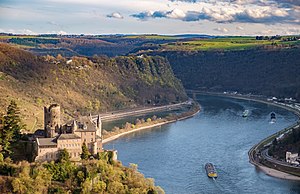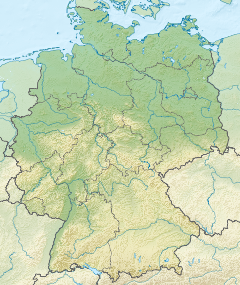Upper Middle Rhine Valley
 |
|
| UNESCO World Heritage Site | |
|---|---|
| Official name | Upper Middle Rhine Valley |
| Location | Germany |
| Coordinates | 50°10′25″N 7°41′39″E / 50.1736°N 7.6942°E |
| Includes |
Stolzenfels Castle |
| Criteria | Cultural: ii, iv, v |
| Reference | 1066 |
| Inscription | 2002 (26th Session) |
|
[]
|
|
The Rhine Gorge is a popular name for the Upper Middle Rhine Valley, a 65 km section of the Rhine between Koblenz and Bingen in Germany. It was added to the UNESCO list of World Heritage Sites in June 2002 for a unique combination of geological, historical, cultural and industrial reasons.
The region's rocks were laid down in the Devonian period and are known as Rhenish Facies. This is a fossil-bearing sedimentary rock type consisting mainly of slate. The rocks underwent considerable folding during the Carboniferous period. The gorge was carved out during a much more recent uplift to leave the river contained within steep walls 200 m high, the most famous feature being the Loreley.
The gorge produces its own microclimate and has acted as a corridor for species not otherwise found in the region. Its slopes have long been terraced for agriculture, in particular viticulture which has good conditions on south-facing slopes. Most of the vineyards belong to the wine region Mittelrhein, but the southernmost parts of the Rhine Gorge fall in Rheingau and Nahe.
The river has been an important trade route into central Europe since prehistoric times and a string of small settlements has grown up along the banks. Constrained in size, many of these old towns retain a historic feel today. With increasing wealth, many castles appeared and the valley became a core region of the Holy Roman Empire. It was at the centre of the Thirty Years' War, which left many of the castles in ruins, a particular attraction for today's cruise ships which follow the river. At one time forming a border of France, in the 19th Century the valley became part of Prussia and its landscape became the quintessential image of Germany.
...
Wikipedia

